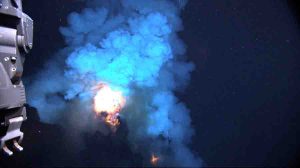
Scientists funded by NOAA and the National Science Foundation recorded the deepest erupting volcano yet discovered, describing high-definition video of the undersea eruption as “spectacular.” Eruption of the West Mata volcano, discovered in May, occurred nearly 4,000 feet below the surface of the Pacific Ocean, in an area bounded by Fiji, Tonga and Samoa.
Imagery includes large molten lava bubbles approximately three feet across bursting into cold seawater, glowing red vents explosively ejecting lava into the sea, and the first-observed advance of lava flows across the deep-ocean seafloor. Sounds of the explosive eruption were recorded by a hydrophone and later matched to the video footage.
“We found a type of lava never before seen erupting from an active volcano, and for the first time observed molten lava flowing across the deep-ocean seafloor,” said the mission’s Chief Scientist Joseph Resing, a chemical oceanographer at the University of Washington who collaborates with NOAA through the Joint Institute for the Study of the Atmosphere and Ocean. “Though NOAA and partners discovered a much shallower eruption in 2004 in the Mariana Arc, the deeper we get, the closer the eruption is to those that formed most of the oceanic crust.”
“It was an underwater Fourth of July – a spectacular display of fireworks nearly 4,000 feet deep,” said Co-Chief Scientist Bob Embley, a marine geologist based in the Newport, Ore., office of NOAA’s Pacific Marine Environmental Laboratory. “Since the water pressure at that depth suppresses the violence of the volcano’s explosions, we could get the underwater robot within feet of the active eruption. On land, or even in shallow water, you could never hope to get this close and see such great detail,” he said.
Mission scientists released the video and discussed their scientific observations at a Dec. 17 news conference at the American Geophysical Union’s annual fall meeting in San Francisco.
“For the first time we have been able to examine, up close, the way ocean islands and submarine volcanoes are born,” says Barbara Ransom, program director in NSF’s Division of Ocean Sciences. “The unusual primitive compositions of the West Mata eruption lavas have much to tell us.”
The West Mata volcano is producing Boninite lavas, believed to be among the hottest erupting on Earth in modern times, and a type only seen before on extinct volcanoes older than a million years. University of Hawaii geochemist Ken Rubin believes this active Boninite eruption provides a unique opportunity to study magma formation at volcanoes and how the Earth recycles material where one tectonic plate is subducted under another – a long-term goal of many Earth scientists.
Water from the volcano is very acidic, with some samples collected directly above the eruption measuring somewhere between battery acid and stomach acid. Julie Huber, a microbiologist at the Marine Biological Laboratory, found diverse microbes even in such extreme conditions.
Tim Shank, a biologist at the Woods Hole Oceanographic Institution (WHOI), found shrimp were the only animals thriving in the acidic vent water near the eruption. Shank is analyzing shrimp DNA to determine if they are the same species as those found at eruptive seamounts more than 3,000 miles away.
Mission scientists believe 80 percent of eruptive activity on Earth takes place in the ocean, and most volcanoes are in the deep ocean. Until this discovery, NOAA and NSF had sponsored research on submarine volcanoes for 25 years without observing a deep-ocean eruption. Scientists believe further study of active deep-ocean eruptions will provide a better understanding of oceanic cycles of carbon dioxide and sulfur gases, how heat and matter are transferred from the interior of the Earth to its surface, and how life adapts to some of the harshest conditions on Earth.
The science team operated from the University of Washington’s research vessel Thomas Thompson, and deployed Jason, a remotely-operated underwater robot operated by WHOI that is recognized as one of the most capable in the world. Jason collected samples using its manipulator arms and obtained imagery using a prototype still and HD imaging system developed and operated by the Advanced Imaging and Visualization Lab at WHOI.
Other participants included Oregon State University, Monterey Bay Aquarium Research Institute, Western Washington University, Portland State University, Harvard University, the University of Tulsa, California State University’s Moss Landing Marine Laboratory, the University of California Santa Cruz and Lamont Doherty Earth Observatory.
The National Science Foundation is an independent U.S. government agency responsible for promoting science and engineering through research programs and education projects.
NOAA understands and predicts changes in the Earth’s environment, from the depths of the ocean to the surface of the sun, and conserves and manages our coastal and marine resources.
Note: The above post is reprinted from materials provided by National Oceanic and Atmospheric Administration.










